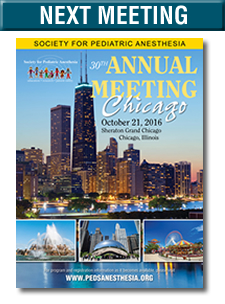Pediatric anesthesiology 2016 reviews
Session V-1: The ABC of CAB-Circulation, Airway, Breathing
 Reviewed by RJ Ramamurthi, MD, FRCA
Reviewed by RJ Ramamurthi, MD, FRCA
Stanford University School of Medicine
and Lucille Packard Children's Hospital
Jennifer K. Lee, MD (Johns Hopkins University, Baltimore), gave an excellent refresher on the recent updates in Pediatric Advanced Life Support (PALS) resuscitation guidelines. This informative update focused on changes made in 2015 which replace the 2010 version of the resuscitation guidelines. Since most of the data are derived from adult studies, Dr. Lee pointed out the lack of comparable pediatric studies in many of the new recommendations.
A list of the updates presented includes:
- To improve much needed blood ‘flow’ to vital organs, PALS emphasizes Compressions, Airway, Breathing (C-A-B).
- A chest compression rate of 100-120 is advised for children of all ages.
- Though routine use is now discouraged, a pre-intubation dose of atropine is 0.02mg/kg and there is no longer a minimum dose recommendation.
- E-CPR should be considered for cardiac arrests in children with pre-existing cardiac issues.
- Though it is useful to have ETCO2 monitoring during chest compressions, currently there are no recommendations for minimal ETCO2 as guidance for effective CPR.
- In the management of refractory VF, use of lidocaine is supported by current literature and so the new guideline has added lidocaine to amiodarone as the drugs of choice for refractory VF.
- Optimal DC shock levels are another area of conflicting results. As the recent literature suggest higher chances of recovery from VF following shock levels of 4 J/Kg, the current recommendation suggest starting with that level. But for ease of teaching, 2010 guidelines are still considered valid (first shock 2J/kg, second shock 4J/kg, subsequent shocks ≥4J/kg, max 10J/kg or adult dose).
- Though there is general agreement on avoidance of post-resuscitation hyperthermia, induced hypothermia still lacks evidence in children to support routing use.
- Last but not least, post-resuscitation FiO2 should be titrated to maintain SaO2 >94, but <100, avoiding hyperoxia.





